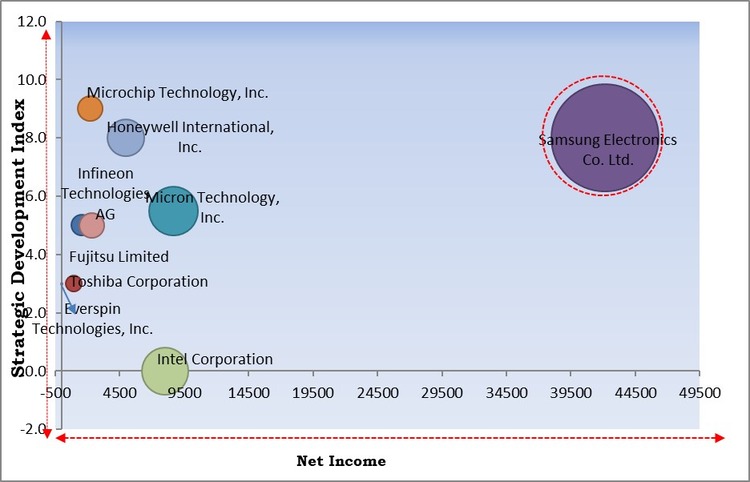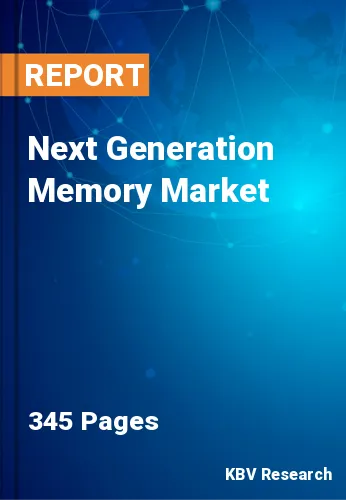The Global Next Generation Memory Market size is expected to reach $21.8 billion by 2030, rising at a market growth of 17.2% CAGR during the forecast period.
Integrating next generation memory technologies brings significant benefits to the forefront of the BFSI industry. These solutions' rapidity and effectiveness are essential for enhancing data analytics and real-time transaction processing capabilities. Therefore, the BFSI sector would generate 1/5th share of the market by 2030. Financial institutions are able to make decisions more quickly and accurately, which is crucial in markets where even milliseconds can have a significant impact. Additionally, data integrity is guaranteed by the non-volatile nature of some next generation memory types, which is crucial for upholding regulatory compliance and preserving trust. Enhancing operational efficiency as well as data security in the BFSI sector is mainly dependent on next generation memory due to the growing volume of financial data and the requirement for strong security measures.

The major strategies followed by the market participants are Product Launches as the key developmental strategy to keep pace with the changing demands of end users. For instance, In October, 2023, Everspin Technologies, Inc. launched the EMxxLX to enhance the high-density STT-MRAM product family. The EMxxLX is an xSPI serial interface for persistent memory. The new product has the features of a clock frequency of 200 MHz and a bandwidth of 400 megabytes per second using eight I/O signals. Additionally, In July, 2023, Samsung Electronics Co. Ltd. launched the Graphics Double Data Rate 7 (GDDR7) DRAM. The new product helps enhance user experiences and provides exceptional graphics performance on game consoles and workstations. Additionally, the new product has applications in AI and automotive vehicles.
Based on the Analysis presented in the KBV Cardinal matrix; Samsung Electronics Co. Ltd. is the forerunner in the Market. Companies such as Micron Technology, Inc., Honeywell International, Inc., Infineon Technologies AG are some of the key innovators in the Market. In October, 2023, Micron Technology, Inc. launched the 16Gb DDR5 memory to enhance its 1β (1-beta) process node technology product portfolio. The new product has the features of 4-phase clocking, clock-sync and high-k CMOS device technology. Additionally, the new product helps to increase performance by 50% and provides an improvement in performance per watt of 33% over the previous generation.

The surge in demand for high-performance data processing is driven by the growing complexity of data-intensive applications and the need for more efficient memory solutions that can keep pace with the escalating processing requirements. Next Generation Memory technologies, including MRAM, PCM, and others, are uniquely positioned to meet these demands, and their integration into various sectors has ushered in several notable developments. One prominent consequence of this heightened demand is the acceleration of innovation within the Next Generation Memory industry. Next Generation Memory solutions are also crucial for the success of in-memory computing, as they provide the high-speed data access required for this approach. In conclusion, the growing demand for high-performance data processing has been a catalyst for transformative change within the market.
As technology continues to advance and new paradigms such as edge computing, the Internet of Things (IoT), 5G, and artificial intelligence (AI) gain momentum, the demand for memory solutions that can meet the performance and reliability requirements grows. One of the most noteworthy outcomes of this synergy is the convergence of Next Generation Memory technologies with edge computing. Edge computing requires efficient data handling at the network's periphery, close to data sources. Next-generation memory's high-speed data access and low latency make it an ideal companion for edge devices and gateways. As edge computing becomes integral to applications like autonomous vehicles, smart cities, and industrial automation, Next Generation Memory technologies ensure rapid data processing and real-time decision-making at the edge. As AI continues to evolve and shape industries such as healthcare, finance, and autonomous systems, the demand for advanced memory technologies will intensify. Therefore, all of these developments will aid in the expansion of the market.
The development and production of next-generation memory, such as MRAM and 3D XPoint, involves intricate and specialized processes. These processes often require sophisticated manufacturing facilities, equipment, and a skilled workforce. The initial investment needed to establish such infrastructure can be prohibitively high, making it challenging for smaller players to compete in the market. Moreover, high manufacturing costs directly impact the pricing of Next Generation Memory products. When production expenses are substantial, manufacturers often transfer these costs to consumers, resulting in higher retail prices. In the consumer electronics sector, where price sensitivity is prevalent, the adoption of these technologies may be hampered by their relatively high cost.

The leading players in the market are competing with diverse innovative offerings to remain competitive in the market. The above illustration shows the percentage of revenue shared by some of the leading companies in the market. The leading players of the market are adopting various strategies in order to cater demand coming from the different industries. The key developmental strategies in the market are Product Launches and Product Expansions.
On the basis of wafer size, the market is divided into 200 nm and 300 nm. The 200 nm segment recorded a substantial revenue share in the market in 2022. The semiconductor industry benefits significantly from the use of 200 mm wafer size. Cost-effectiveness is a major advantage since producing smaller wafers is typically less expensive. This is appealing to companies looking to cut costs and streamline their manufacturing processes without sacrificing the performance and quality of next generation memory components. When smaller production volumes are adequate, 200 mm wafers are especially appealing for specialized applications and niche markets. Their flexibility enables businesses to meet specific customer needs without requiring large-scale production facilities.

Based on technology, the market is bifurcated into volatile and non-volatile. The non-volatile segment garnered the highest revenue share in the market in 2022. Non-volatile technology offers a number of benefits that are essential for contemporary enterprises. Their capacity to store data even in the absence of power is one of their most notable qualities. Faster boot times and better data integrity are made possible by non-volatile technology, which is essential for applications like financial transactions and crucial data storage where data consistency is vital. Non-volatile memory is necessary for improving energy efficiency, extending mobile device battery life, and lowering data center operating expenses.
By vertical, the market is segmented into BFSI, consumer electronics, government, telecommunications, information technology, enterprise storage, automotive & transportation, and others. The enterprise storage region witnessed the largest revenue share in the market in 2022. Next Generation memory technologies, such as MRAM and PCM, provide significantly faster data access times compared to traditional storage solutions like NAND flash. This translates to reduced latency, allowing enterprises to access and process data more quickly. In real-time data analysis, high-frequency trading, and database applications, reduced latency is a game-changer. Many next generation memory types are non-volatile, meaning they retain data even when power is removed. This is advantageous in enterprise storage systems, as it guarantees data integrity and preserves critical information in the event of power failures or outages.
| Report Attribute | Details |
|---|---|
| Market size value in 2022 | USD 6.3 Billion |
| Market size forecast in 2030 | USD 21.8 Billion |
| Base Year | 2022 |
| Historical Period | 2019 to 2021 |
| Forecast Period | 2023 to 2030 |
| Revenue Growth Rate | CAGR of 17.2% from 2023 to 2030 |
| Number of Pages | 345 |
| Number of Table | 504 |
| Report coverage | Market Trends, Revenue Estimation and Forecast, Segmentation Analysis, Regional and Country Breakdown, Competitive Landscape, Market Share Analysis, Companies Strategic Developments, Company Profiling |
| Segments covered | Wafer Size, Technology, Vertical, Region |
| Country scope | US, Canada, Mexico, Germany, UK, France, Russia, Spain, Italy, China, Japan, India, South Korea, Singapore, Malaysia, Brazil, Argentina, UAE, Saudi Arabia, South Africa, Nigeria |
| Growth Drivers |
|
| Restraints |
|
Region-wise, the market is analyzed across North America, Europe, Asia Pacific, and LAMEA. The Asia Pacific region acquired the maximum revenue share in the market in 2022. Next Generation memory technology is rapidly being adopted in this region due to a number of factors that are in line with the changing business environment in the region. The demand for energy-efficient memory solutions to preserve data in power-off scenarios has increased due to the rapid development of IoT devices throughout Asia Pacific countries. The proliferation of smart devices and the tech-savvy consumer base in the region are the direct causes of this demand. Asia Pacific is a hotspot for the production of semiconductors due to its robust manufacturing ecosystem.
Free Valuable Insights: Global Next Generation Memory Market size to reach USD 21.8 Billion by 2030
The market research report covers the analysis of key stake holders of the market. Key companies profiled in the report include Samsung Electronics Co. Ltd., Micron Technology, Inc., Fujitsu Limited, Toshiba Corporation, Honeywell International, Inc., Microchip Technology, Inc., Everspin Technologies, Inc., Infineon Technologies AG, Kingston Technology Company, Inc., and Intel Corporation.
By Technology
By Wafer Size
By Vertical
By Geography
This Market size is expected to reach $21.8 billion by 2030.
Rising demand for high-performance data processing are driving the Market in coming years, however, Significantly high manufacturing costs restraints the growth of the Market.
Samsung Electronics Co. Ltd., Micron Technology, Inc., Fujitsu Limited, Toshiba Corporation, Honeywell International, Inc., Microchip Technology, Inc., Everspin Technologies, Inc., Infineon Technologies AG, Kingston Technology Company, Inc., and Intel Corporation.
The expected CAGR of this Market is 17.2% from 2023 to 2030.
The 300 mm segment is leading the Market, By Wafer Size in 2022 thereby achieving a market value of $14.6 billion by 2030.
The Asia Pacific region dominated the Market, By Region in 2022, and would continue to be a dominant market till 2030; thereby, achieving a market value of $9.5 billion by 2030.
Our team of dedicated experts can provide you with attractive expansion opportunities for your business.

